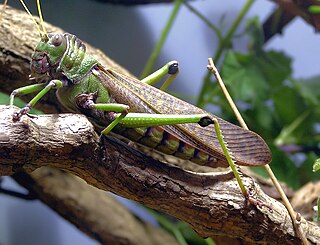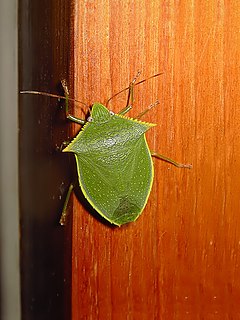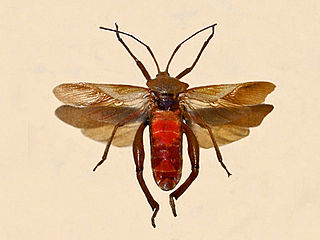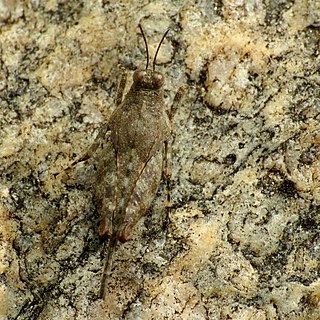
Ranatra is a genus of slender predatory insects of the family Nepidae, known as water scorpions or water stick-insects. There are around 100 Ranatra species found in freshwater habitats around the world, both in warm and temperate regions, with the highest diversity in South America and Asia. Fewer are found elsewhere, but include several African, some in North America, three from Australia and three from the Palearctic, notably the relatively well-known European R. linearis.

The Romaleidae or lubber grasshoppers are a family of grasshoppers, based on the type genus Romalea. The species in this family can be found in the Americas.

Ambroise Marie François Joseph Palisot, Baron de Beauvois was a French naturalist.

Loxa is an insect genus in the large family of shield bugs. It occurs primarily in Central America and Mexico, but is also found in Texas, Florida and South America. While Loxa is a genus of the tribe Pentatomini, its species are similar in many respects to those in the Chlorocorini, specifically the genera: ChlorocorisSpinola, ChloropeplaStål, MayriniaHorvath and FeceliaStål. Some species of Loxa are minor crop pests, for example Loxa deducta.

The Harpactorinae are a large subfamily of the Reduviidae. About 300 genera and 2,000 species worldwide have been described. Some of the species of the genera Zelus, Pselliopus, Sinea, and Apiomerus are of interest as biological pest control agents.

Sphedanolestes is a large genus of assassin bugs in the family (Reduviidae), subfamily Harpactorinae. There are more than 190 described species, which are found in southern Europe, Africa and Asia.

Rhynocoris is a genus of assassin bug, family (Reduviidae), in the subfamily Harpactorinae. Species are recorded from Asia, mainland Europe, Africa and North America.

Acanthaspis is a genus of assassin bugs. Members of the genus are known to disguise themselves by attaching bits of debris to aid in camouflage.
Zenoa picea is a species of beetles in the family Callirhipidae, and the only species in the genus Zenoa. It was described by Palisot de Beauvois in 1805.

Pseudocreobotra ocellata, known as the African flower mantis or with other species as the spiny flower mantis, is a flower mantis native to Africa, ranging from Angola and South Africa in the south to Uganda in the east and Senegal in the west. It was described by the French naturalist Palisot de Beauvois in 1805.

Ugada is a genus of cicadas from Africa.

Pseudocreobotra is a genus of Sub-Saharan flower mantises. They are visually similar to Creobroter species of Asia, but belong to different subfamilies. Their forewings have prominent spiralled eyespots, which are flashed in a silent deimatic display, to startle would-be predators. The nymphs however, expand the raised abdomen in response to threats, to reveal a single dorsal eyespot. The species are easily reared in captivity.

Plectropoda is a genus of squash bugs belonging to the family Coreidae.

Coranus is a genus of assassin bugs in the tribe Harpactorini.

Paratettix is a genus of ground-hoppers or pygmy grasshoppers, with more than 60 described species found worldwide.

Proxys is a genus of stink bugs in the family Pentatomidae. There are about six described species in Proxys.

Nagusta is a genus of assassin bugs in the family Reduviidae.

Dulichius is a genus of bugs in the family Alydidae and tribe Micrelytrini. It is notable for species which are ant mimics.

Epidaus is a genus of assassin bugs with about 25 species mainly distributed mainly in the Oriental Realm with two species which extend into the Palearctic Realm. Most species have a long and narrow body with the pronotum having a posterior margin with raised corners and spiny outgrowths facing outwards. The head a tubercle behind the base of each of the two antennae.

Salyavatinae are a subfamily of the assassin bugs. They have a pan-tropical distribution with about 16 genera. They have two foretarsal segments and have a patch of fine hairs known as the fossula spongiosa on the fore and mid tibia. Many species tend to have spines on the head, pronotum, legs and abdomen. A few species have the foretibia flattened into leaf-like structures.


















